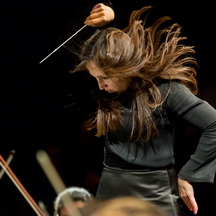Powerful—and anachronistic
The Vienna Philharmonic came to Zellerbach Hall for three days in an unprecedented residency February 25 – 27.
These were old-school Austrians with names like Johannes, as in Johannes Brahms, or Johann, as in Strauss or Bach. And there were seven Wolfgangs, as in Wolfgang Amadeus Mozart. Their recordings are masterful, but in their group picture there are only three women and no people of color among a hundred and thirty tuxedos and tails, a sad companion to that old school mastery.
While blind auditions are toppling many limits, audiences increasingly question the place of prejudice in art. This orchestra too is changing. But that change is slow, with an additional barrier: before being inducted into the Philharmonic they must belong to the Vienna State Opera orchestra, an elite—and elitist—institution.
For a traditional orchestra, however, they do old school to the nines.
At a Friday morning rehearsal open to UC Berkeley music students they shivered the air with Mahler’s Symphony No. 6, spilling over Zellerbach’s vaulted spaces with a huge sound that was as clean as it was dense.
That rounded unity is the key to this orchestra: while other violinists go to conservatories to become soloists—the next Joshua Bell or Anne-Sophie Mutter—the violinists of Vienna aspire to be part of a legendary blend. Additionally, their conductors have been “guest” conductors since 1933, fostering a democratic atmosphere for their camaraderie.
Like ecclesiastical garbs, which reflect the zenith of a faith’s power, the instruments of the Vienna Philharmonic appear to be frozen in time. The horns have an older style of valve, reversed from the present day, but their smaller bore and heavier weight give them a wider range of coloring. And that rotary valve, as opposed to the agility of today’s piston valve, makes for more seamless entrances. The winds are similarly anachronistic, favoring the flexible synthesis of an ensemble, as opposed to the distinctiveness of a soloist.
When I first heard Mahler’s thunder I knew that this was how it was intended. But then again, Mahler had for many years forbidden his wife Alma from composing, a loss for the ages.
But the purity of their conception! At the end of Schumann’s Symphony No. 2 on Saturday, the gentleman next to me turned and said, “And that is how it’s done.”
Of course, their empathy and power was also attributable to conductor Semyon Bychkov, who inspired his musicians without recourse to a score. His passion in the Schumann was direct and sensual. Coaxing small nuances and broad gestures, he helped propel their penetration in every octave. In other words, that first movement was luscious.
After the second movement’s remarkable agility came a timeless rendition of the gently sorrowful Adagio. Oboe, flute and clarinet took turns softly cresting over the blend, a seamless hand-off one to another and then to the torrid strings. And then, Schumann’s triumphant resolution.
After intermission came Brahms’ abiding love in Symphony No. 2. Clean counterpoints thickened gestures of sweeping grandeur, a neo-Romantic vision of Nature in exquisite bud and violent storm. Powerful statements had us swimming in sound, and I recalled that a friend of Brahms wrote of his weeping as he ran through a sun-lit glade. In the gentle Allegretto a wealth of horns was silvered with flutes for one sweet instrument. And then the huge arc of the finale, a carefully wrought structure of majesty and love, with Bychkov dancing on the podium, from the swirling strings to the brassy joy of the conclusion.
They encored with pure schmaltz, Brahms’ Hungarian Dance No. 5, delighting in lilt married to shtick. Which of course raises a question: when will these fine male musicians find some ladies to dance with?
—Adam Broner
